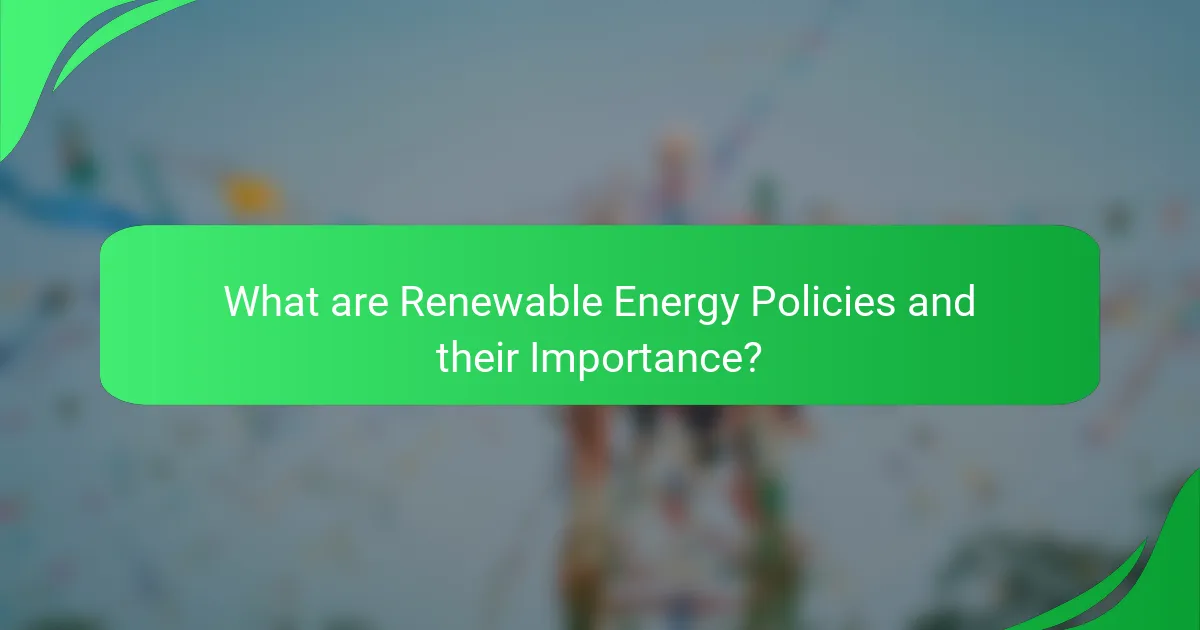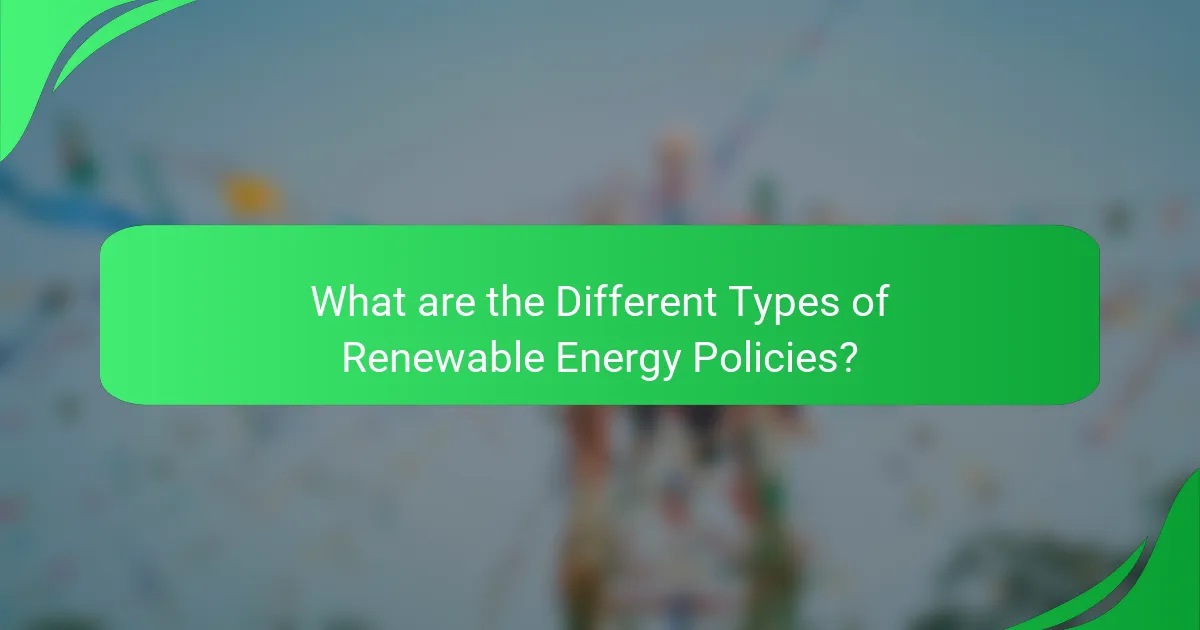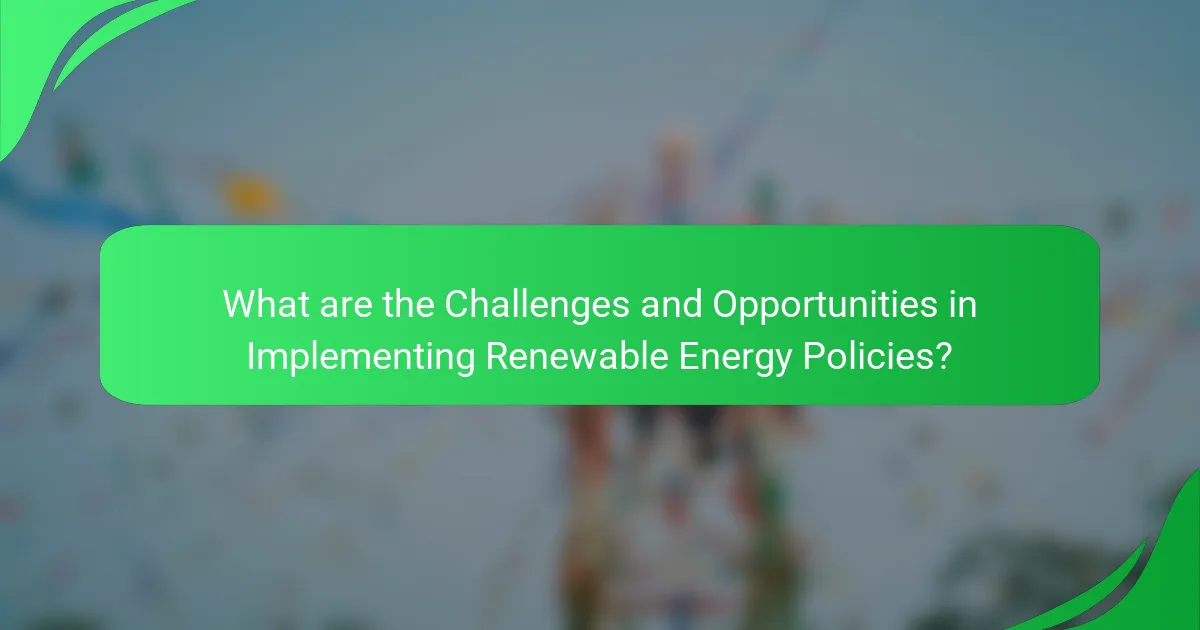Renewable energy policies are essential regulations and guidelines that facilitate the development and utilization of renewable energy sources, aiming to decrease reliance on fossil fuels and lower greenhouse gas emissions. These policies encompass various incentives such as tax credits, subsidies, and grants, while also establishing generation targets and energy efficiency standards. The article explores the types of renewable energy policies, including feed-in tariffs and renewable portfolio standards, and discusses the challenges and opportunities associated with their implementation. Evidence indicates that strong renewable energy policies can lead to significant job creation and advancements in energy technology, underscoring their critical role in fostering sustainable development and enhancing energy security.

What are Renewable Energy Policies and their Importance?
Renewable energy policies are regulations and guidelines that promote the development and use of renewable energy sources. These policies aim to reduce reliance on fossil fuels and decrease greenhouse gas emissions. They often include incentives such as tax credits, subsidies, and grants for renewable energy projects. Renewable energy policies also establish targets for renewable energy generation and set standards for energy efficiency. Their importance lies in fostering sustainable development by addressing climate change, enhancing energy security, and creating jobs in the green economy. According to the International Renewable Energy Agency, renewable energy could create 24 million jobs globally by 2030. Thus, effective renewable energy policies are crucial for a sustainable future.
How do Renewable Energy Policies influence Sustainable Development?
Renewable energy policies significantly influence sustainable development by promoting clean energy sources. These policies encourage investment in renewable technologies like solar and wind. They reduce reliance on fossil fuels, which lowers greenhouse gas emissions. Cleaner energy contributes to improved air quality and public health. Additionally, renewable energy policies create job opportunities in emerging green industries. They stimulate economic growth through innovation and infrastructure development. Effective policies can enhance energy security by diversifying energy sources. Countries with strong renewable energy policies often experience increased energy access, particularly in underserved regions.
What are the key objectives of Renewable Energy Policies?
The key objectives of Renewable Energy Policies are to increase the share of renewable energy in the energy mix and to reduce greenhouse gas emissions. These policies aim to enhance energy security by diversifying energy sources. They also promote economic growth through job creation in the renewable sector. Furthermore, they seek to foster technological innovation in clean energy technologies. Supporting rural development is another objective, as renewable energy projects can benefit local communities. Additionally, these policies aim to improve public health by reducing air pollution. Finally, they contribute to achieving international climate commitments, such as the Paris Agreement.
How do these policies contribute to environmental sustainability?
Renewable energy policies contribute to environmental sustainability by promoting clean energy sources. These policies reduce greenhouse gas emissions significantly. For instance, transitioning from fossil fuels to solar and wind energy can cut emissions by up to 80%. They also encourage energy efficiency, which lowers overall energy consumption. Additionally, these policies often include incentives for renewable energy technologies. This leads to increased investment in sustainable infrastructure. Moreover, renewable energy policies help preserve natural resources. By decreasing reliance on non-renewable resources, they protect ecosystems and biodiversity. Overall, these policies foster a sustainable energy future that mitigates climate change impacts.
Why is Government Support Crucial for Renewable Energy Policies?
Government support is crucial for renewable energy policies because it provides the necessary funding and regulatory framework. This support helps to lower the costs of renewable technologies. For instance, government incentives can reduce the financial burden on developers. Additionally, public policies can create a stable market for renewable energy. This stability encourages investments from private sectors. According to the International Renewable Energy Agency, government support has led to a 70% decrease in solar energy costs since 2010. Furthermore, government-backed initiatives can drive research and innovation in renewable technologies. These efforts are essential for achieving long-term sustainability goals.
What role does legislation play in promoting renewable energy?
Legislation plays a critical role in promoting renewable energy by establishing frameworks for development and investment. It provides incentives such as tax credits, rebates, and grants to encourage the adoption of renewable technologies. Specific laws set renewable energy targets that utilities must meet, driving demand for clean energy sources. For example, the Renewable Portfolio Standards in various states require a certain percentage of energy to come from renewable sources. Additionally, legislation can streamline permitting processes, reducing barriers to project development. Studies show that countries with strong renewable energy policies see higher investments in clean energy. The International Renewable Energy Agency reported that supportive legislation significantly boosts renewable energy capacity and job creation.
How do financial incentives affect the adoption of renewable energy technologies?
Financial incentives significantly enhance the adoption of renewable energy technologies. These incentives lower the initial costs associated with purchasing and installing renewable energy systems. For example, tax credits can reduce the financial burden on consumers and businesses. Grants and subsidies can provide direct financial support, making renewable options more accessible. Research indicates that countries with robust financial incentives see higher installation rates of solar panels and wind turbines. A study by the International Renewable Energy Agency found that financial incentives can increase renewable energy investments by up to 50%. This correlation demonstrates that financial support is crucial for accelerating the transition to renewable energy.

What are the Different Types of Renewable Energy Policies?
The different types of renewable energy policies include feed-in tariffs, renewable portfolio standards, tax incentives, and grants. Feed-in tariffs guarantee fixed payments for energy producers who generate renewable energy. Renewable portfolio standards require utilities to obtain a certain percentage of their energy from renewable sources. Tax incentives reduce the financial burden on individuals and companies investing in renewable energy technologies. Grants provide direct funding to support renewable energy projects. Each of these policies aims to encourage the adoption of renewable energy and reduce reliance on fossil fuels.
How do Feed-in Tariffs work in promoting renewable energy?
Feed-in Tariffs (FiTs) guarantee a fixed payment for energy producers who generate renewable energy. This financial incentive encourages the development of renewable energy sources like solar and wind. By providing a stable income, FiTs reduce the financial risk for investors. Countries implementing FiTs have seen significant increases in renewable energy capacity. For example, Germany’s FiT policy led to a tenfold increase in solar energy production from 2000 to 2010. This policy not only promotes investment but also supports job creation in the renewable sector. Overall, FiTs play a crucial role in transitioning to a more sustainable energy system.
What are the advantages and disadvantages of Feed-in Tariffs?
Feed-in Tariffs (FiTs) provide guaranteed payments for energy producers who generate renewable energy. The advantages include stable income for producers, which encourages investment in renewable technologies. FiTs promote the growth of the renewable energy sector by making it financially viable for small-scale producers. They also facilitate energy diversification and reduce reliance on fossil fuels.
However, disadvantages exist. FiTs can lead to higher energy costs for consumers due to the subsidies required. They may also create market distortions if not properly managed. Additionally, there is a risk of overcapacity if too many producers enter the market, which can lead to inefficiencies. Overall, while FiTs support renewable energy growth, they require careful implementation to mitigate potential drawbacks.
How do Feed-in Tariffs impact energy market dynamics?
Feed-in Tariffs (FiTs) incentivize renewable energy production by guaranteeing fixed payments for energy supplied to the grid. This policy encourages investment in renewable technologies like solar and wind. Increased renewable energy generation leads to a more diverse energy mix. FiTs can lower electricity prices in the long term by promoting competition. They also stimulate job creation in the renewable sector. In Germany, the introduction of FiTs in 2000 resulted in a significant increase in solar capacity, reaching over 40 GW by 2019. This shift impacts traditional energy markets by reducing reliance on fossil fuels. Overall, FiTs drive a transition toward sustainable energy systems.
What is the role of Renewable Portfolio Standards?
Renewable Portfolio Standards (RPS) mandate that a certain percentage of energy must come from renewable sources. RPS aims to increase the use of renewable energy, reduce greenhouse gas emissions, and promote energy diversity. These standards are implemented by various states and countries to encourage investment in clean energy technologies. According to the U.S. Department of Energy, RPS has led to significant growth in renewable energy capacity. For instance, states with RPS have seen an increase in wind and solar installations. This growth contributes to job creation in the renewable energy sector. Additionally, RPS helps stabilize energy prices by reducing dependency on fossil fuels. Overall, RPS plays a crucial role in transitioning towards a sustainable energy future.
How do Renewable Portfolio Standards ensure a percentage of energy from renewable sources?
Renewable Portfolio Standards (RPS) mandate that a specific percentage of energy must come from renewable sources. These standards are implemented by governments to promote the use of clean energy. Utilities are required to obtain a certain amount of their energy from renewable resources like wind, solar, and hydro. Failure to meet these requirements can result in penalties. RPS programs create a market for renewable energy credits. These credits can be bought and sold, encouraging investment in renewable technologies. Studies show that RPS has significantly increased the share of renewables in the energy mix. For example, states with RPS have seen a 20% increase in renewable energy generation since their implementation.
What are the challenges associated with implementing Renewable Portfolio Standards?
Implementing Renewable Portfolio Standards (RPS) faces several challenges. One major challenge is the variability of renewable energy sources. For instance, solar and wind energy depend on weather conditions, making it difficult to ensure a consistent energy supply. Another challenge is the potential for increased costs. Transitioning to renewable sources can require significant investment in infrastructure and technology. Regulatory complexities also pose challenges. Different states may have varying requirements, complicating compliance for energy providers. Additionally, there may be resistance from traditional energy sectors. Established fossil fuel industries often lobby against RPS, impacting policy effectiveness. Lastly, achieving public acceptance can be challenging. Communities may have concerns about land use and environmental impacts associated with renewable projects.

What are the Challenges and Opportunities in Implementing Renewable Energy Policies?
The challenges in implementing renewable energy policies include high initial costs and technological barriers. These costs can deter investment and slow down adoption. Regulatory hurdles also complicate the integration of renewable sources into existing energy systems. Additionally, public resistance can arise due to misinformation or lack of awareness.
Opportunities in this area are significant. Renewable energy policies can lead to job creation in green technology sectors. They can also enhance energy security by reducing dependence on fossil fuels. Furthermore, these policies can drive innovation, leading to advancements in energy efficiency and storage solutions.
Evidence shows that countries with strong renewable policies have seen substantial growth in clean energy sectors. For instance, according to the International Renewable Energy Agency, global renewable energy jobs reached 12 million in 2020, highlighting the potential for employment growth.
What barriers hinder the effectiveness of Renewable Energy Policies?
Barriers that hinder the effectiveness of renewable energy policies include financial constraints, regulatory challenges, and lack of public awareness. Financial constraints limit investments needed for renewable energy projects. High upfront costs deter both private and public sector funding. Regulatory challenges arise from inconsistent policies and bureaucratic hurdles. Complex permitting processes can delay project implementation. Lack of public awareness leads to insufficient support for renewable initiatives. This results in lower adoption rates among consumers and businesses. Research indicates that these barriers collectively impede the transition to sustainable energy systems. For instance, a study by the International Renewable Energy Agency found that financial barriers are among the top reasons for slow renewable energy deployment.
How do economic factors affect policy implementation?
Economic factors significantly influence policy implementation by affecting resource allocation and prioritization. Budget constraints can limit the scope of renewable energy initiatives. Economic growth or recession impacts government revenues, altering funding availability. High unemployment rates may shift focus from environmental policies to job creation. Inflation affects the cost of renewable technologies, influencing adoption rates. Market conditions determine the feasibility of investments in renewable energy projects. Economic incentives can encourage or discourage policy compliance among stakeholders. For instance, tax credits for solar energy increase adoption rates, demonstrating a direct correlation between economic factors and policy success.
What social and political challenges arise in promoting renewable energy?
Social and political challenges in promoting renewable energy include resistance from established fossil fuel industries. These industries often have significant political influence and lobbying power. Additionally, public perception of renewable energy can be mixed. Some communities may resist projects due to concerns about land use or local environmental impacts.
Policy frameworks can also create barriers. Inconsistent regulations can hinder investment and development in renewable technologies. Furthermore, there may be socioeconomic disparities in access to renewable energy benefits. Low-income communities often lack resources to invest in renewable technologies.
Political will is essential for effective policy implementation. However, competing interests can lead to stalled legislation. For example, some politicians may prioritize short-term economic gains over long-term sustainability. These factors create a complex landscape for promoting renewable energy initiatives.
How can Renewable Energy Policies be improved for better outcomes?
Renewable energy policies can be improved by increasing financial incentives for clean energy technologies. Enhanced tax credits and subsidies can encourage investment in renewable sources. Streamlining permitting processes can reduce delays in project implementation. Additionally, establishing clear, long-term goals can provide stability for investors. Integrating renewable energy into existing infrastructure can optimize resource use. Public engagement and education can foster community support for renewable projects. Lastly, regular assessments of policy effectiveness can ensure continuous improvement. Studies indicate that countries with robust renewable policies see greater energy transition success. For instance, Germany’s feed-in tariff has significantly boosted solar energy adoption.
What best practices can be adopted from successful case studies?
Best practices from successful case studies in renewable energy policies include comprehensive stakeholder engagement, clear policy frameworks, and robust monitoring systems. Stakeholder engagement ensures that diverse perspectives are considered, leading to more effective policies. Clear policy frameworks provide direction and stability, which are essential for attracting investment. Robust monitoring systems allow for the assessment of policy effectiveness and facilitate necessary adjustments. Evidence from case studies, such as Germany’s Energiewende, shows that these practices lead to increased renewable energy adoption and reduced carbon emissions.
How can stakeholder engagement enhance policy effectiveness?
Stakeholder engagement enhances policy effectiveness by incorporating diverse perspectives and expertise. Engaging stakeholders fosters collaboration and builds trust among parties involved. This collaborative approach leads to more informed decision-making. Policies that reflect stakeholder input are often more relevant and practical. Research shows that inclusive policies are more likely to gain public support. For instance, the International Renewable Energy Agency found that stakeholder involvement in energy policy leads to better implementation outcomes. Effective engagement can also identify potential barriers early, allowing for proactive solutions. Overall, stakeholder engagement creates a more robust framework for effective policy development and implementation.
What practical steps can individuals and communities take to support Renewable Energy Policies?
Individuals and communities can support renewable energy policies by advocating for local legislation. They can attend town hall meetings to express support for renewable initiatives. Communities can form groups to educate others about the benefits of renewable energy. Individuals should consider installing solar panels or wind turbines at home. Participating in community solar projects also helps increase renewable energy usage. Supporting local businesses that prioritize renewable energy is vital. Engaging with policymakers through petitions can amplify community voices. Lastly, promoting energy conservation practices complements renewable energy efforts.
The main entity of this article is Renewable Energy Policies. These policies are essential for promoting sustainable development by encouraging the use of renewable energy sources, reducing greenhouse gas emissions, and enhancing energy security. The article outlines the importance of government support, the role of legislation, and various financial incentives that facilitate the adoption of renewable technologies. It also discusses the challenges and opportunities in implementing these policies, highlighting best practices and the significance of stakeholder engagement in achieving effective outcomes. Overall, the article emphasizes the critical role of renewable energy policies in fostering a sustainable future.